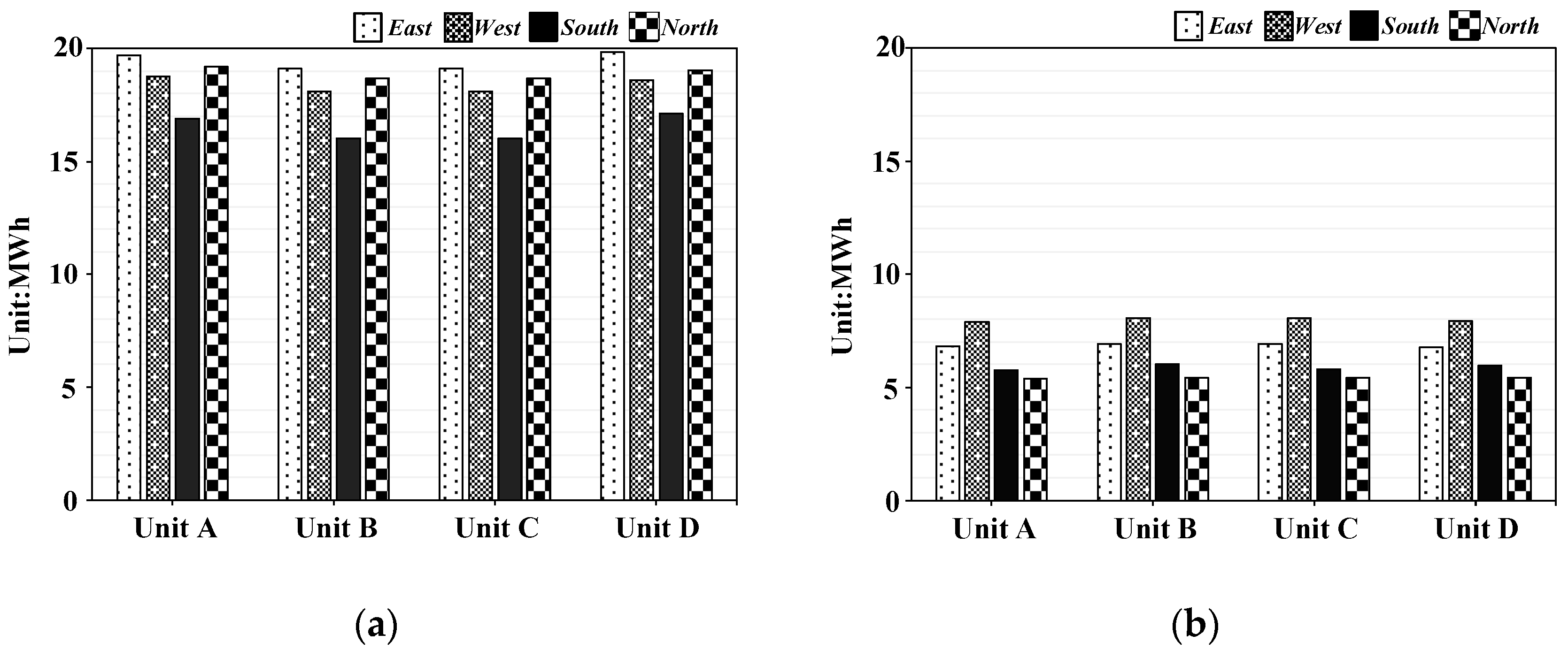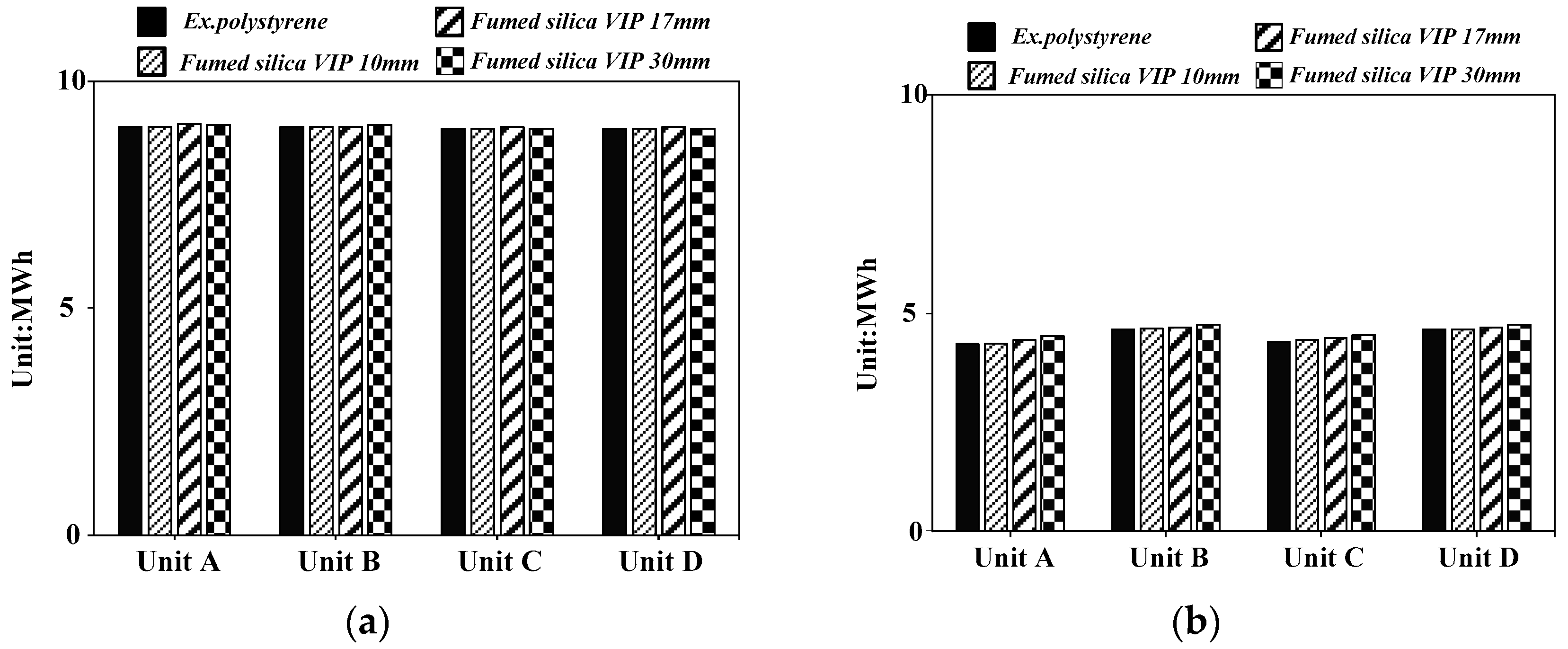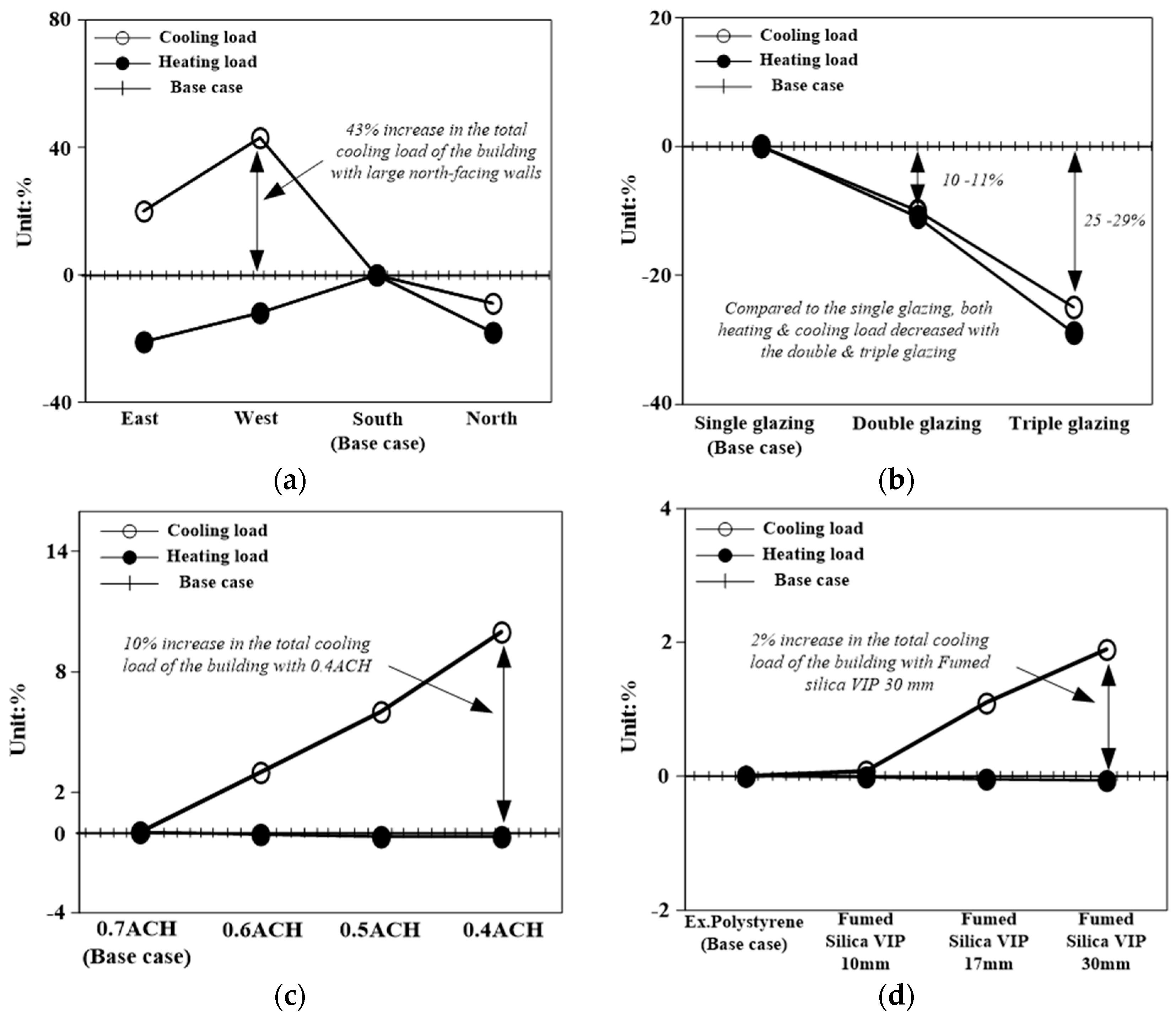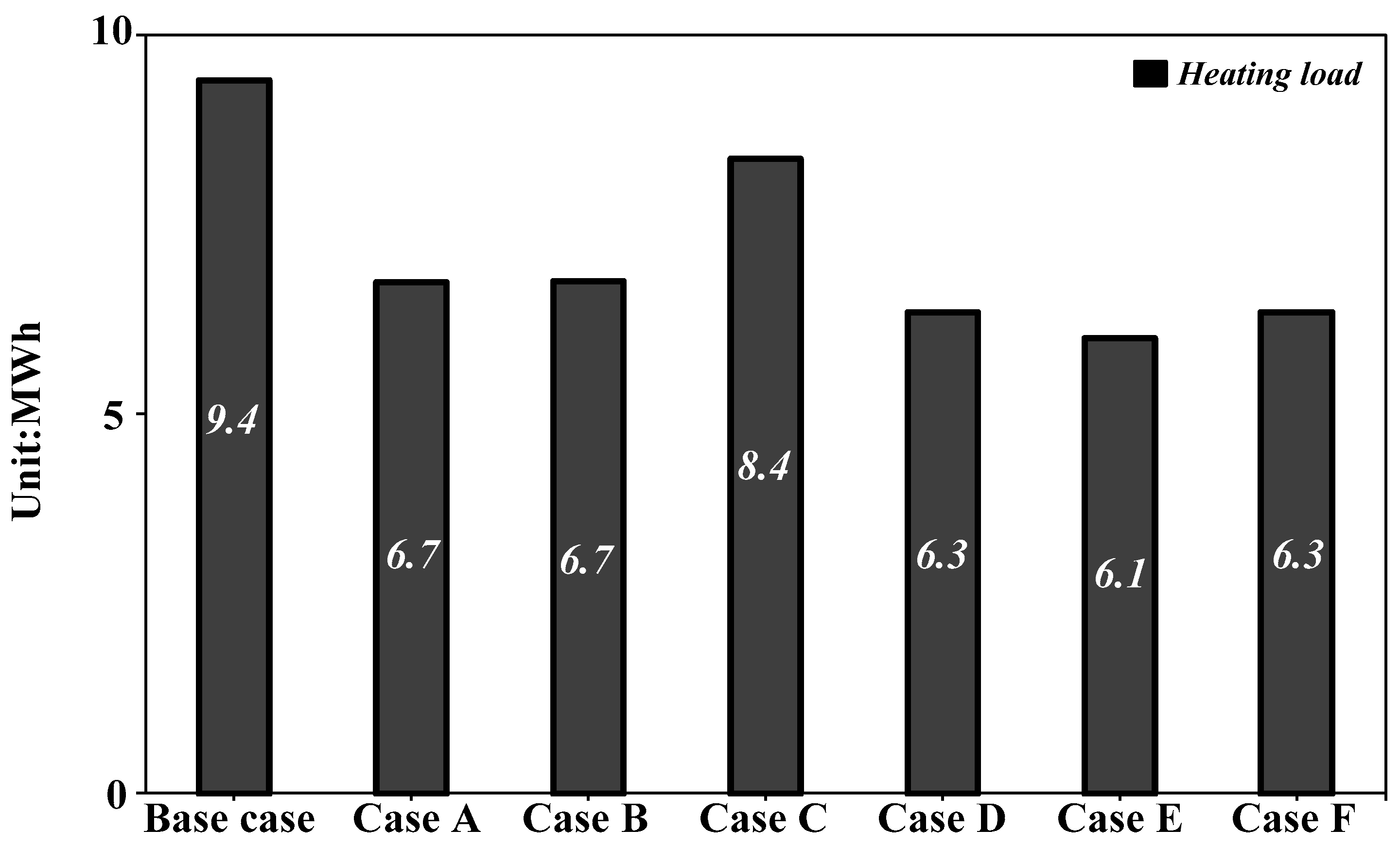A Comparative Study of Energy Performance of Fumed Silica Vacuum Insulation Panels in an Apartment Building
Abstract
1. Introduction
2. Fumed Silica VIPs
3. Methodology
3.1. Building Descriptions
3.2. IES-VE Modeling Process
4. Results
4.1. Building Orientations
4.2. Window Glazing Type
4.3. Air Infiltration Rates
4.4. Fumed Silica VIPs
4.5. Comparisons of the Heating and Cooling Loads in the Unit
4.6. Energy Efficient Strategies to Reduce Building Energy Consumptions
5. Conclusions
Author Contributions
Conflicts of Interest
References
- Pérez-Lombard, L.; Ortiz, J.; Pout, C. A review on buildings energy consumption information. Energy Build. 2008, 40, 394–398. [Google Scholar] [CrossRef]
- Shariah, A.; Tashtoush, B.; Rousan, A. Cooling and heating loads in residential buildings in Jordan. Energy Build. 1997, 26, 137–143. [Google Scholar] [CrossRef]
- Shariah, A.; Shalabi, B.; Rousan, A.; Tashtoush, B. Effects of absorptance of external surfaces on heating and cooling loads of residential buildings in Jordan. Energy Convers. Manag. 1998, 39, 273–284. [Google Scholar] [CrossRef]
- Jim, C.Y. Air-conditioning energy consumption due to green roofs with different building thermal insulation. Appl. Energy 2014, 128, 49–59. [Google Scholar] [CrossRef]
- Stavrakakis, G.M.; Androutsopoulos, A.V.; Vyörykkä, J. Experimental and numerical assessment of cool-roof impact on thermal and energy performance of a school building in Greece. Energy Build. 2016, 130, 64–84. [Google Scholar] [CrossRef]
- Zagorskas, J.; Zavadskas, E.K.; Turskis, Z.; Burinskienė, M.; Blumberga, A.; Blumberga, D. Thermal insulation alternatives of historic brick buildings in Baltic Sea Region. Energy Build. 2014, 78, 35–42. [Google Scholar] [CrossRef]
- Copiello, S. Building energy efficiency: A research branch made of paradoxes. Renew. Sustain. Energy Rev. 2017, 69, 1064–1076. [Google Scholar] [CrossRef]
- Papadopoulos, A.M. State of the art in thermal insulation materials and aims for future developments. Energy Build. 2005, 37, 77–86. [Google Scholar] [CrossRef]
- Pargana, N.; Pinheiro, M.D.; Silvestre, J.D.; de Brito, J. Comparative environmental life cycle assessment of thermal insulation materials of buildings. Energy Build. 2014, 82, 466–481. [Google Scholar] [CrossRef]
- Biswas, K.; Shrestha, S.S.; Bhandari, M.S.; Desjarlais, A.O. Insulation materials for commercial buildings in North America: An assessment of lifetime energy and environmental impacts. Energy Build. 2016, 112, 256–269. [Google Scholar] [CrossRef]
- Khoukhi, M.; Fezzioui, N.; Draoui, B.; Salah, L. The impact of changes in thermal conductivity of polystyrene insulation material under different operating temperatures on the heat transfer through the building envelope. Appl. Therm. Eng. 2016, 105, 669–674. [Google Scholar] [CrossRef]
- Jiang, L.; Xiao, H.; An, W.; Zhou, Y.; Sun, J. Correlation study between flammability and the width of organic thermal insulation materials for building exterior walls. Energy Build. 2014, 82, 243–249. [Google Scholar] [CrossRef]
- Stec, A.A.; Hull, T.R. Assessment of the fire toxicity of building insulation materials. Energy Build. 2011, 43, 498–506. [Google Scholar] [CrossRef]
- Schiavoni, S.; D’Alessandro, F.; Bianchi, F.; Asdrubali, F. Insulation materials for the building sector: A review and comparative analysis. Renew. Sustain. Energy Rev. 2016, 62, 988–1011. [Google Scholar] [CrossRef]
- Hidalgo, J.P.; Welch, S.; Torero, J.L. Performance criteria for the fire safe use of thermal insulation in buildings. Construct. Build. Mater. 2015, 100, 285–297. [Google Scholar] [CrossRef]
- Doroudiani, S.; Doroudiani, B.; Doroudiani, Z. Materials that release toxic fumes during fire. In Toxicity of Building Materials; Pacheco-Torgal, F., Jalali, S., Fucic, A., Eds.; Woodhead Publishing: Sawston, Cambridge, UK, 2012; Chapter 9; pp. 241–282. [Google Scholar]
- Nemanič, V.; Zajec, B.; Žumer, M.; Figar, N.; Kavšek, M.; Mihelič, I. Synthesis and characterization of melamine–formaldehyde rigid foams for vacuum thermal insulation. Appl. Energy 2014, 114, 320–326. [Google Scholar] [CrossRef]
- Di, X.; Gao, Y.; Bao, C.; Ma, S. Thermal insulation property and service life of vacuum insulation panels with glass fiber chopped strand as core materials. Energy Build. 2014, 73, 176–183. [Google Scholar] [CrossRef]
- Karami, P.; Al-Ayish, N.; Gudmundsson, K. A comparative study of the environmental impact of Swedish residential buildings with vacuum insulation panels. Energy Build. 2015, 109, 183–194. [Google Scholar] [CrossRef]
- Jelle, B.P. Traditional, state-of-the-art and future thermal building insulation materials and solutions—Properties, requirements and possibilities. Energy Build. 2011, 43, 2549–2563. [Google Scholar] [CrossRef]
- Boafo, F.E.; Chen, Z.; Li, C.; Li, B.; Xu, T. Structure of vacuum insulation panel in building system. Energy Build. 2014, 85, 644–653. [Google Scholar] [CrossRef]
- Baetens, R.; Jelle, B.P.; Thue, J.V.; Tenpierik, M.J.; Grynning, S.; Uvsløkk, S.; Gustavsen, A. Vacuum insulation panels for building applications: A review and beyond. Energy Build. 2010, 42, 147–172. [Google Scholar] [CrossRef]
- Johansson, P.; Geving, S.; Hagentoft, C.-E.; Jelle, B.P.; Rognvik, E.; Kalagasidis, A.S.; Time, B. Interior insulation retrofit of a historical brick wall using vacuum insulation panels: Hygrothermal numerical simulations and laboratory investigations. Build. Environ. 2014, 79, 31–45. [Google Scholar] [CrossRef]
- Kalnæs, S.E.; Jelle, B.P. Vacuum insulation panel products: A state-of-the-art review and future research pathways. Appl. Energy 2014, 116, 355–375. [Google Scholar] [CrossRef]
- Choi, J.-H. Investigation of the correlation of building energy use intensity estimated by six building performance simulation tools. Energy Build. 2017, 147, 14–26. [Google Scholar] [CrossRef]
- Abdul Mujeebu, M.; Ashraf, N.; Alsuwayigh, A. Energy performance and economic viability of nano aerogel glazing and nano vacuum insulation panel in multi-story office building. Energy 2016, 113, 949–956. [Google Scholar] [CrossRef]
- Abdul Mujeebu, M.; Ashraf, N.; Alsuwayigh, A.H. Effect of nano vacuum insulation panel and nanogel glazing on the energy performance of office building. Appl. Energy 2016, 173, 141–151. [Google Scholar] [CrossRef]
- Johansson, P.; Adl-Zarrabi, B.; Sasic Kalagasidis, A. Evaluation of 5 years’ performance of VIPs in a retrofitted building façade. Energy Build. 2016, 130, 488–494. [Google Scholar] [CrossRef]
- Mukhopadhyaya, P.; MacLean, D.; Korn, J.; van Reenen, D.; Molleti, S. Building application and thermal performance of vacuum insulation panels (VIPs) in Canadian subarctic climate. Energy Build. 2014, 85, 672–680. [Google Scholar] [CrossRef]
- Kwon, J.-S.; Jung, H.; Yeo, I.S.; Song, T.-H. Outgassing characteristics of a polycarbonate core material for vacuum insulation panels. Vacuum 2011, 85, 839–846. [Google Scholar] [CrossRef]
- Di, X.; Gao, Y.; Bao, C.; Hu, Y.; Xie, Z. Optimization of glass fiber based core materials for vacuum insulation panels with laminated aluminum foils as envelopes. Vacuum 2013, 97, 55–59. [Google Scholar] [CrossRef]
- Johansson, P.; Hagentoft, C.-E.; Sasic Kalagasidis, A. Retrofitting of a listed brick and wood building using vacuum insulation panels on the exterior of the facade: Measurements and simulations. Energy Build. 2014, 73, 92–104. [Google Scholar] [CrossRef]
- Firląg, S.; Zawada, B. Impacts of airflows, internal heat and moisture gains on accuracy of modeling energy consumption and indoor parameters in passive building. Energy Build. 2013, 64, 372–383. [Google Scholar] [CrossRef]
- Yaşa, E.; Ok, V. Evaluation of the effects of courtyard building shapes on solar heat gains and energy efficiency according to different climatic regions. Energy Build. 2014, 73, 192–199. [Google Scholar] [CrossRef]
- Katafygiotou, M.C.; Serghides, D.K. Analysis of structural elements and energy consumption of school building stock in Cyprus: Energy simulations and upgrade scenarios of a typical school. Energy Build. 2014, 72, 8–16. [Google Scholar] [CrossRef]
- Yang, T.; Pan, Y.; Mao, J.; Wang, Y.; Huang, Z. An automated optimization method for calibrating building energy simulation models with measured data: Orientation and a case study. Appl. Energy 2016, 179, 1220–1231. [Google Scholar] [CrossRef]
- Delgarm, N.; Sajadi, B.; Delgarm, S.; Kowsary, F. A novel approach for the simulation-based optimization of the buildings energy consumption using NSGA-II: Case study in Iran. Energy Build. 2016, 127, 552–560. [Google Scholar] [CrossRef]
- Jang, H.; Kang, J. A stochastic model of integrating occupant behaviour into energy simulation with respect to actual energy consumption in high-rise apartment buildings. Energy Build. 2016, 121, 205–216. [Google Scholar] [CrossRef]
- Papadopoulos, S.; Azar, E. Integrating building performance simulation in agent-based modeling using regression surrogate models: A novel human-in-the-loop energy modeling approach. Energy Build. 2016, 128, 214–223. [Google Scholar] [CrossRef]
- Calcerano, F.; Martinelli, L. Numerical optimisation through dynamic simulation of the position of trees around a stand-alone building to reduce cooling energy consumption. Energy Build. 2016, 112, 234–243. [Google Scholar] [CrossRef]
- Chen, L.; Basu, B.; McCabe, D. Fractional order models for system identification of thermal dynamics of buildings. Energy Build. 2016, 133, 381–388. [Google Scholar] [CrossRef]
- Crawley, D.B.; Hand, J.W.; Kummert, M.; Griffith, B.T. Contrasting the capabilities of building energy performance simulation programs. Build. Environ. 2008, 43, 661–673. [Google Scholar] [CrossRef]
- Taleb, H.M. Enhancing the skin performance of hospital buildings in the UAE. J. Build. Eng. 2016, 7, 300–311. [Google Scholar] [CrossRef]
- Barbhuiya, S.; Barbhuiya, S. Thermal comfort and energy consumption in a UK educational building. Build. Environ. 2013, 68, 1–11. [Google Scholar] [CrossRef]
- Choi, I.Y.; Cho, S.H.; Kim, J.T. Energy consumption characteristics of high-rise apartment buildings according to building shape and mixed-use development. Energy Build. 2012, 46, 123–131. [Google Scholar] [CrossRef]
- Park, J.H.; Chung, M.H.; Park, J.C. Development of a small wind power system with an integrated exhaust air duct in high-rise residential buildings. Energy Build. 2016, 122, 202–210. [Google Scholar] [CrossRef]
- Du, Z.; Jin, X.; Fang, X.; Fan, B. A dual-benchmark based energy analysis method to evaluate control strategies for building HVAC systems. Appl. Energy 2016, 183, 700–714. [Google Scholar] [CrossRef]
- Aparicio Ruiz, P.; Sánchez de la Flor, F.J.; Molina Felix, J.L.; Salmerón Lissén, J.; Guadix Martín, J. Applying the HVAC systems in an integrated optimization method for residential building’s design. A case study in Spain. Energy Build. 2016, 119, 74–84. [Google Scholar] [CrossRef]
- Wang, Y.; Kuckelkorn, J.; Zhao, F.-Y.; Liu, D.; Kirschbaum, A.; Zhang, J. Evaluation on classroom thermal comfort and energy performance of passive school building by optimizing HVAC control systems. Build. Environ. 2015, 89, 86–106. [Google Scholar] [CrossRef]
- Hong, G.; Kim, B.S. Field measurements of infiltration rate in high rise residential buildings using the constant concentration method. Build. Environ. 2016, 97, 48–54. [Google Scholar] [CrossRef]
- Pacheco-Torgal, F. Introduction to Cost-Effective Energy-Efficient Building Retrofitting. In Cost-Effective Energy Efficient Building Retrofitting; Pacheco-Torgal, F., Granqvist, C.-G., Jelle, B.P., Vanoli, G.P., Bianco, N., Kurnitski, J., Eds.; Woodhead Publishing: Sawston, Cambridge, UK, 2017; Chapter 1; pp. 1–20. [Google Scholar]









| Element | Constructions | U-Factor (W/m2K) |
|---|---|---|
| Wall | Dense concrete + Insulation | 0.39 |
| Internal partition | Concrete (200 mm) | 2.48 |
| Glass (including frame) | 6 mm + 6 mm (low-e) (Total shading coefficient: 0.7467) (Visible light transmittance: 0.76) | 1.97 |
| Slab | Sandy soil + Polystyrene + Concrete | 0.41 |
| Ceiling | Sandy soil + Polystyrene + Concrete | 0.95 |
| Part | Values | |
|---|---|---|
| Design temperature | cooling set-point | 26 °C |
| heating set-point | 20 °C | |
| Humidity | 30–70% | |
| People | 4 persons (sensible gain: 90 W/person, latent heat: 60 W/person) | |
| Use schedule | all day used | |
| Infiltration rate [50] | 0.7 ACH | |
| Weather data | Seoul, Korea (latitude: 37°, longitude: 127°) | |
| Part | Conditions |
|---|---|
| Orientation | East |
| West | |
| South | |
| North | |
| Window system | Single glazing with low-e coating |
| Double glazing with low-e coating | |
| Triple glazing with low-e coating | |
| Infiltration ACH | 0.7 |
| 0.6 | |
| 0.5 | |
| 0.4 | |
| Insulation | Expanded Polystyrene |
| Fumed Silica VIP—10 mm | |
| Fumed Silica VIP—17 mm | |
| Fumed Silica VIP—30 mm | |
| Shading device | External shading device |
| Wall/Window | Type of Insulation | Material Composition | U-Value (W/m2K) |
|---|---|---|---|
| External Wall | Expanded polystyrene | Concrete (200 mm) + Insulation (80 mm) | 0.37 |
| Fumed silica (10 mm) | Concrete (200 mm) + Insulation (10 mm) | 0.39 | |
| Fumed silica (17 mm) | Concrete (200 mm) + Insulation (17 mm) | 0.24 | |
| Fumed silica (30 mm) | Concrete (200 mm) + Insulation (30 mm) | 0.14 | |
| External Window | Single glazing Low-e | 6 mm clear + 6 mm low-e | 1.97 |
| Double glazing | 6 mm clear + 12 mm Air + 6 mm low-e | 1.40 | |
| Triple glazing Low-e | 6 mm low-e + 12 mm Argon + 6 mm low-e + 12 mm Argon + 6 mm low-e | 0.68 |
| Case | Condition |
|---|---|
| Base case | Ex. Polystyrene + Single glazing with low-e coating + 0.4 ACH |
| Case A | Ex. Polystyrene + Triple glazing with low-e coating + 0.4 ACH |
| Case B | Ex. Polystyrene + Triple glazing with low-e coating + 0.7 ACH |
| Case C | Fumed silica VIP (17 mm) + Double glazing with low-e coating + 0.4 ACH |
| Case D | Fumed silica VIP (17 mm) + Triple glazing with low-e coating + 0.7 ACH |
| Case E | Fumed silica VIP (30 mm) + Triple glazing with low-e coating + 0.4 ACH |
| Case F | Fumed silica VIP (30 mm) + Triple glazing with low-e coating + 0.7 ACH |
| Case G | Ex. Polystyrene + Single glazing with low-e coating + 0.4 ACH + External shading device |
| Case H | Fumed silica VIP (30 mm) + Triple glazing with low-e coating + 0.7 ACH + External shading device |
© 2017 by the authors. Licensee MDPI, Basel, Switzerland. This article is an open access article distributed under the terms and conditions of the Creative Commons Attribution (CC BY) license (http://creativecommons.org/licenses/by/4.0/).
Share and Cite
Lim, T.; Seok, J.; Kim, D.D. A Comparative Study of Energy Performance of Fumed Silica Vacuum Insulation Panels in an Apartment Building. Energies 2017, 10, 2000. https://doi.org/10.3390/en10122000
Lim T, Seok J, Kim DD. A Comparative Study of Energy Performance of Fumed Silica Vacuum Insulation Panels in an Apartment Building. Energies. 2017; 10(12):2000. https://doi.org/10.3390/en10122000
Chicago/Turabian StyleLim, Taesub, Jaewang Seok, and Daeung Danny Kim. 2017. "A Comparative Study of Energy Performance of Fumed Silica Vacuum Insulation Panels in an Apartment Building" Energies 10, no. 12: 2000. https://doi.org/10.3390/en10122000
APA StyleLim, T., Seok, J., & Kim, D. D. (2017). A Comparative Study of Energy Performance of Fumed Silica Vacuum Insulation Panels in an Apartment Building. Energies, 10(12), 2000. https://doi.org/10.3390/en10122000




